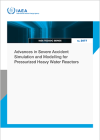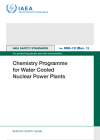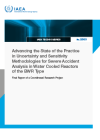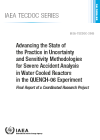Water cooled reactors have played a significant role in the commercial nuclear industry since its beginnings and currently account for more than 95 per cent of all operating civilian power reactors in the world. In addition, the majority of nuclear reactors under development and construction are water-cooled.
Water cooled reactors
Water Cooled Reactors (WCRs) have been the cornerstone of the nuclear industry in the 20th century. Of the currently operating 442 reactors, 96 per cent are water-cooled. Many of these plants were originally licensed to operate for 40 years, but through advances in knowledge, the lives of these plants are now being extended to 60 years, with a potential to operate even longer. It can be expected that WCRs will continue to play an important role in the 21st century.
Light water reactors (LWRs) are the most common WCRs worldwide and are divided into two types: Pressurized Water Reactors (PWRs), which produce steam for the turbine in separate steam generators; and Boiling Water Reactors (BWRs), which use the steam produced inside the reactor core directly in the steam turbine. All LWRs require fuel that is enriched in the fissile isotope, U-235.
Heavy Water Reactors (HWRs) use “enriched” water, the molecules of which comprise hydrogen atoms that are made up to more than 99 per cent of deuterium, a heavier hydrogen isotope. This heavy water, used as a moderator, improves the overall neutron economy, allowing fuel to be used that does not require enrichment.
Many of the lessons learned from the past 50 years of WCR operation, including three major accidents, continue to be applied to the design and operation of existing and advanced WCRs. Recent advances in WCR technology include improvements in existing designs and the development of new designs, sharing the common goals of enhanced safety, a more efficient resource use and better economics. Another important aspect of WCR development is the design, testing and construction of small modular, factory-built integral pressurized water reactors.
While a number of advanced WCRs are currently under construction and available for deployment, innovations in WCR technology continue in the areas of safety, construction technology and economics. Safety systems designed into today’s advanced WCRs have passive features that do not rely on electric power and include larger water inventories, allowing for coping times of days instead of hours in the event of unplanned conditions, such as an extended station blackout.
To improve plant thermal efficiencies and economics, research and development for Supercritical Water Reactors (SCWRs) is being pursued. Supercritical water exists at temperatures and pressures above its critical point, where the liquid and vapor states are indistinguishable. This water is commonly used in advanced coal, oil and gas-fired power plants. Plant efficiencies of SCWRs are expected to be around 1.3 times higher than conventional WCRs.
The Agency fosters an international information exchange related to advances in WCR technology, and provides a forum for international collaboration on technological innovations. It also assists with the sharing of objective and reliable information and understanding of the state-of-the-art in WCR technology. Member States identify areas of interest for international collaboration by participating in the IAEA Technical Working Groups on Advanced Technologies for LWRs and HWRs. These are groups of experts that provide advice and support for programme implementation, reflecting a global network of excellence and expertise with the purpose to advance WCR technologies.








